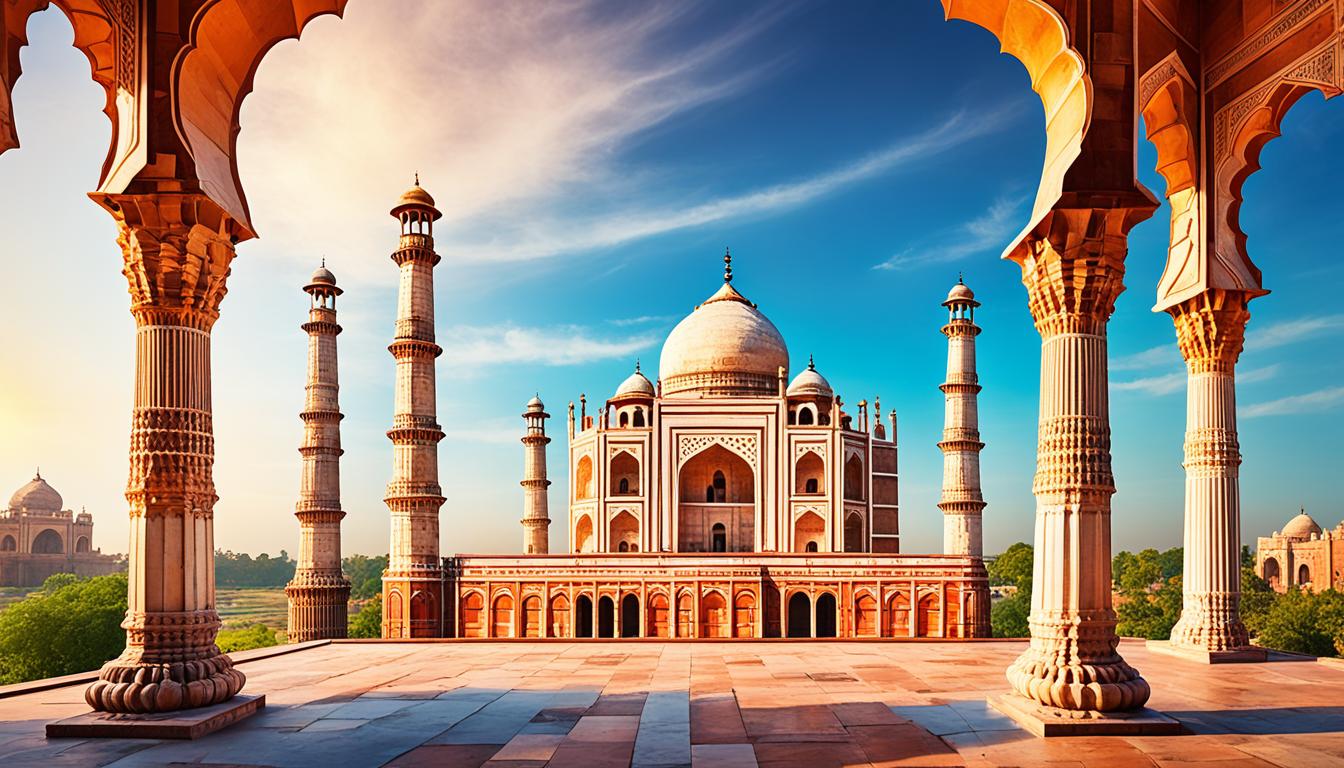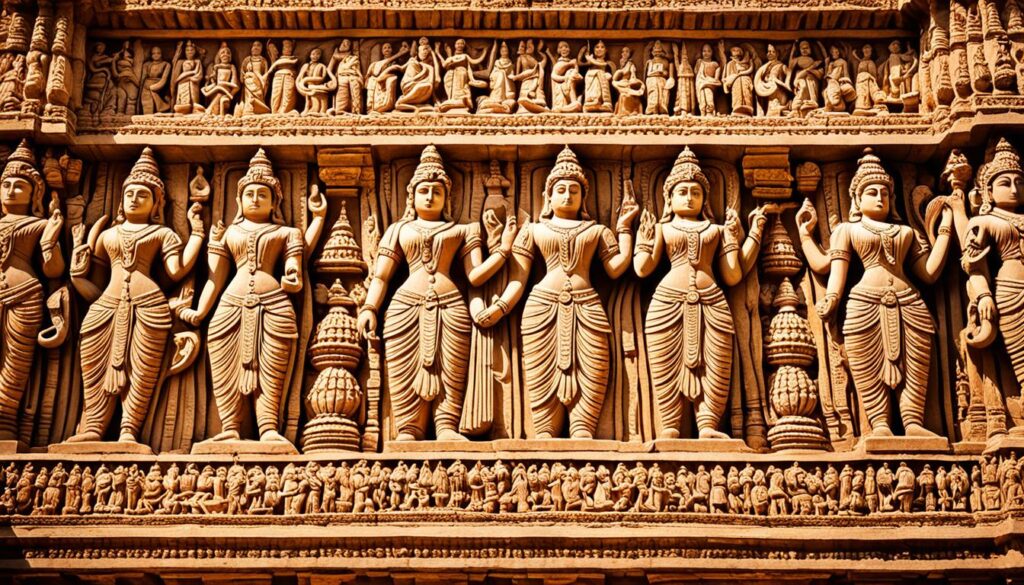
Explore the Seven Wonders of India Today!
India is rich in culture and history, with landmarks that share stories from the past. These seven wonders are not just famous sites; they are the top tourist spots in India. They draw people from everywhere, showing off India’s long history and greatness.
If you love culture or traveling, these places are a must-see for their diversity and beauty. They show off ancient artworks and amazing buildings that stand the test of time. These wonders are a lasting legacy that continues to surprise and excite visitors. Let’s go on an adventure to see the beauty and grandeur of India’s most famous sights.
Unveiling the Magnificence of India’s Seven Wonders
India is a land full of historical wonders that tell stories of a rich past. These wonders showcase spiritual journeys and brilliant architecture. Our journey explores India’s treasured landmarks, starting with Karnataka’s grand Gomateshwara, moving through Hampi’s ancient ruins, and ending at the serene Golden Temple Harmandir Sahib.
Discovering the Monolithic Marvel of Gomateshwara
The monolithic statue of Gomateshwara stands tall in Karnataka, symbolizing peace and serenity. This 58-foot sculpture overlooks Shravanabelagola, representing renunciation and sacrifice. Seeing Gomateshwara connects you to the rich Jain heritage and India’s spiritual history.
Traversing the Historic Terrain of Hampi’s Ruins
The ruins of Hampi bring the ancient Vijayanagara empire back to life. This UNESCO World Heritage site is set among surreal boulders. Its many structures tell tales of royal elegance, making Hampi a must-see for historians and travelers.
Spiritual Serenity at the Golden Temple Harmandir Sahib
The Golden Temple Harmandir Sahib in Punjab is a place of spiritual peacefulness. It is a holy Sikh shrine known for its architectural beauty and serenity. A visit here is a deep dive into the peaceful spirit of India.
A Journey Through India’s Iconic Landmarks
Exploring India is like reading a colorful history and culture book. The country is filled with iconic landmarks in India that tell stories and traditions. When you visit these must-visit places in India, you dive into India’s rich history.
The Red Fort in Delhi is a majestic site. Its red walls have witnessed many historical events. It shows the Mughal era’s creativity and marks India’s journey to independence. The fort is a symbol of India’s pride, especially during Independence Day.
In Rajasthan lies the captivating City Palace of Jaipur. It showcases the lavish life of Maharajas with its magnificent architecture. The palace, with its grand courtyards, tells tales of Royal times. It’s a striking contrast to Jaipur’s bustling markets, showing the city’s royal history and vibrant life.
Heading south, Kerala’s backwaters offer tranquility. These waters reflect the slow life pace of the locals. Surrounded by greenery, these waters are crucial for the community. They showcase Kerala’s rich nature and are peaceful escapes.
| Landmark | Location | Significance |
|---|---|---|
| Red Fort | Delhi | Symbol of India’s sovereignty and historical power center |
| City Palace | Jaipur, Rajasthan | Epitome of Rajputana architecture and royal heritage |
| Backwaters of Kerala | Kerala | Natural waterways offering insights into rural life and biodiversity |
Traveling through India’s landscapes shows the true spirit of its landmarks. Iconic landmarks in India are more than just places to see. They hold stories waiting to be discovered. Visiting these best places to visit in India leaves lasting memories.
Diving Deep into the Architectural Majesty of Ancient India
History is full of stories about ancient civilizations and their architecture. India is known for some of the most beautiful ancient structures in the world. We will look at three famous ancient marvels of India, showing the beauty of an ancient era.
Khajuraho: A Testament to Love and Devotion

Khajuraho is a tribute to love, mysticism, and our connection to the divine. The temples have detailed carvings and sculptures that show life in its purest form. From spirituality to sensuality, everything is depicted. Built between 950 and 1050 AD, these temples showcase Indian architectural skill and the ancient architects’ ability to mix celestial themes with stone.
Konark Sun Temple: A Celestial Saga in Stone
The Konark Sun Temple is known for its architectural beauty and astronomical design. Dedicated to Surya, the sun god, it looks like a chariot. It has seven horses and twelve pairs of wheels which represent the days of the week and the months of the year, respectively. Even after years, the temple continues to amaze visitors with its historical and cultural importance.
Nalanda: Reviving the Prestige of an Ancient Seat of Learning
Once a famous learning center, the ruins of Nalanda University date back to the 5th century CE. Its red brick buildings show what scholarly life was like, covering subjects from theology to medicine. The site of Nalanda still inspires us today with its size and the vision of its founders. It represents a commitment to knowledge and inquiry.
By exploring Khajuraho, the Konark Sun Temple, and Nalanda, we get a glimpse into India’s past. These places show the aesthetic and scientific knowledge of ancient times. They are more than just structures. They are stories of an India that cherished beauty on earth as much as it did connections to the cosmos and the pursuit of knowledge.
The Mystical and Timeless Appeal of the Seven Wonders of India
India is a place where history and the present mix beautifully. The timeless wonders of India are magical landmarks. They capture the heart and soul of anyone who sees them.

Imagine seeing the Taj Mahal at dawn, the calm Dal Lake, or the spiritual Varanasi Ghats. These places capture the essence of time itself. They connect us to something lasting and grand.
These wonders are proof of India’s ancient skills. They are also places where people find beauty and depth. The magical sites mix the past and the present. Each stone and carving tells a story to those willing to hear.
Seeing the Taj Mahal under the stars or Varanasi’s rituals is more than just a sight. It’s like dancing with India’s ageless rhythm.
The wonders of India never stop amazing the world. They’re beyond any list, photo, or words. They invite people from everywhere. They offer a trip not just through time, but into our greatest dreams. Here, the mystical and timeless meet.
Cultural Landmarks of India: Beyond the Surface
India is home to cultural landmarks that offer more than just beauty. These places, like the Amritsar Golden Temple and Konark Sun Temple, are key to India’s cultural story. They share stories of spirituality and ancient wisdom that touch everyone who visits.
Embracing the Spiritual Essence of Amritsar’s Golden Temple
The Amritsar Golden Temple is not just an important site in India, it is also a spiritual hub for Sikhs worldwide. It sits by the Amrit Sarovar lake, welcoming all who come. The temple shines in the sunlight, showing off its marble and gold dome.
This place shares a message of faith and artistry. It makes visitors feel a part of something bigger.
Exploring the Indelible Heritage of the Konark Sun Temple
The heritage of Konark Sun Temple is a grand homage to the sun god Surya. This temple looks like a giant chariot, with twelve pairs of wheels and seven horses. It shows the mastery of Odisha’s Kalinga-style architecture, making it a central cultural site in India.
Both the Golden Temple and the Konark Sun Temple hold deep meanings. They are more than just buildings. They symbolize the heart and history of India’s culture.
Conclusion
The journey through India’s seven wonders ends in deep admiration for its historical and cultural richness. These wonders go beyond being just sights to see. They symbolize India’s rich past and the blend of spirituality and artistry. To visit the seven wonders is to travel across time and see monuments that tell stories silently.
Our trip reminds us of India’s role in the world’s grand story. It calls to those eager to explore India’s soul, carved in stone and faith. These wonders draw people worldwide, making India even more attractive.
For anyone wanting to understand India, the seven wonders are key. They link the ancient with the modern, urging us to explore India’s heritage. As we end, the seven wonders invite us to experience a world of endless wonder. So, get ready to visit India and experience its breathtaking beauty for yourself.
FAQ
What are the seven wonders of India?
India’s seven wonders are Gomateshwara, Hampi, Golden Temple Harmandir Sahib, Red Fort, City Palace, Backwaters of Kerala, Taj Mahal, Dal Lake, and Varanasi Ghats.
What is the significance of Gomateshwara?
Gomateshwara is a giant statue in Karnataka, India. It’s important to Jains and shows Lord Bahubali. The 57-foot statue is known for its detailed carvings.
What can I explore at Hampi’s ruins?
Hampi is in Karnataka and is a UNESCO World Heritage Site. It has ancient city remains. Visitors can see old structures, temples, and ruins, learning about the Vijayanagara Empire.
What makes the Golden Temple Harmandir Sahib special?
Located in Amritsar, Punjab, the Golden Temple is Sikhism’s holiest shrine. Its golden look, peaceful environment, and the free meals served daily in its community kitchen are notable. It welcomes thousands of people every day.
What is the architectural significance of the Red Fort?
The Red Fort in Delhi was the Mughal emperors’ home. It combines Mughal, Persian, and Indian designs. People admire its marble work and gardens.
What can I experience at the City Palace?
Jaipur’s City Palace blends Rajasthani and Mughal styles. You can tour its grand halls, museums, and galleries. This gives a glimpse into Jaipur’s royal past.
What is special about the Backwaters of Kerala?
Kerala’s Backwaters offer a peaceful experience in beautiful scenery. You can take houseboat cruises, see village life, and try local dishes. The area has lagoons, lakes, and canals.
What is the cultural and historical significance of the Taj Mahal?
The Taj Mahal in Agra is a famous UNESCO World Heritage Site. Emperor Shah Jahan built it for his wife, Mumtaz Mahal. Its beauty, marble designs, and love story make it a top place to visit.
Source Links
- https://traveltriangle.com/blog/seven-wonders-of-india/
- https://medium.com/@indiaprivatedriver/the-seven-wonders-of-india-that-everyone-should-explore-b982deeb9fe
- https://www.oyorooms.com/travel-guide/seven-wonders-of-india/

Leave a Reply